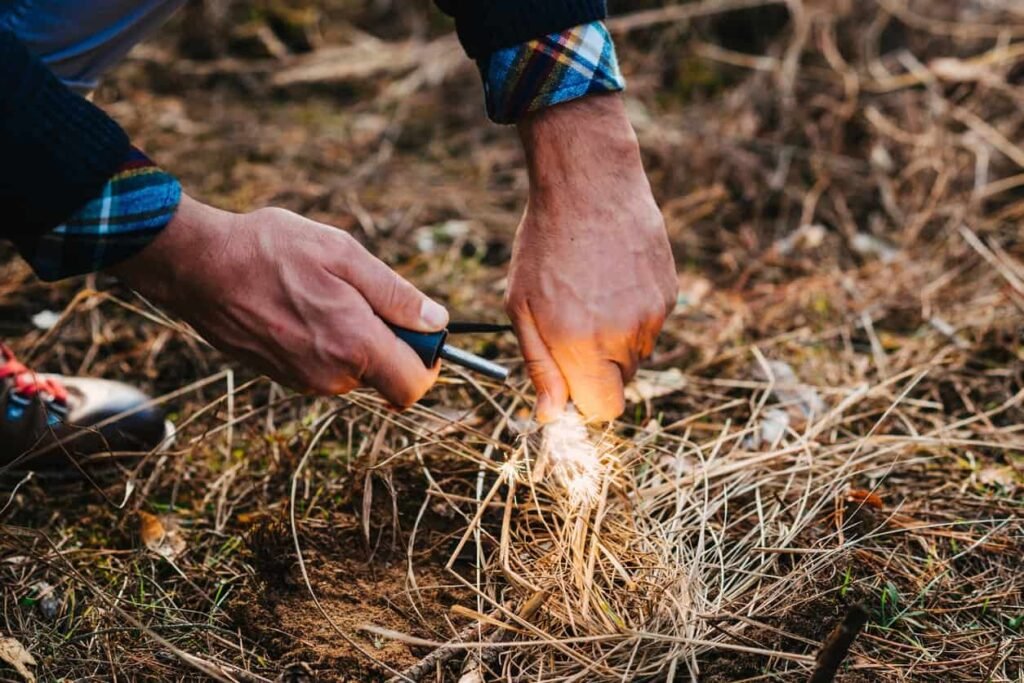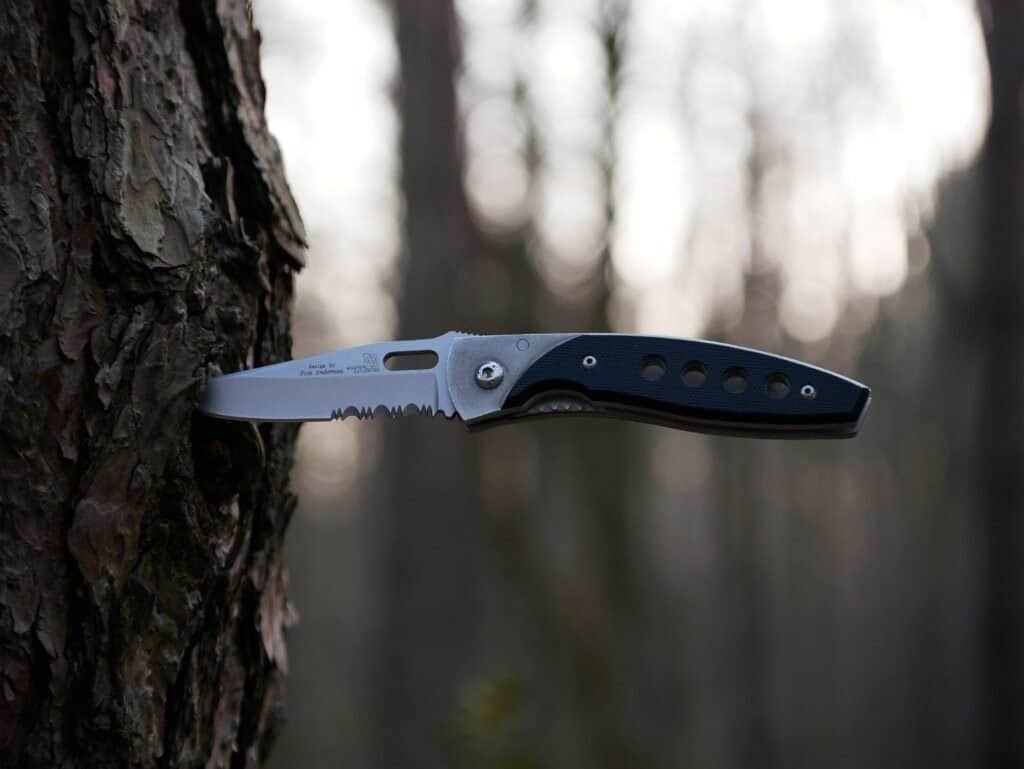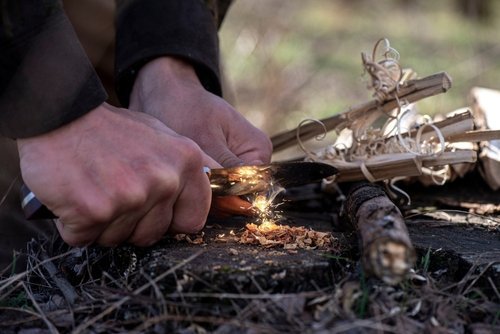
In the world of outdoor adventure and survival, the humble Ferro rod has long been an essential tool. Its ability to spark fire in challenging conditions has saved lives and provided warmth and sustenance to countless explorers. However, a persistent question lingers in the minds of outdoor enthusiasts: “Do ferro rods dull knives?”
In this comprehensive exploration, we delve deep into this intriguing debate. We’ll uncover the science behind knife sharpness, scrutinize the factors that contribute to blade dulling, and examine the role of ferro rods in this context. With expert insights, real-world experiences, and practical advice, we aim to demystify this common myth and equip you with the knowledge to make informed choices in your outdoor pursuits. So, let’s embark on this journey to separate fact from fiction and unveil the truth about ferro rods and knife sharpness.
Understanding Ferro Rods

Composition and Ignition Mechanism
Ferro rods are primarily composed of an alloy containing iron, cerium, lanthanum, and other rare earth metals. This alloy is pyrophoric, meaning it can ignite when struck against a rough surface, generating a shower of sparks. These sparks reach temperatures of around 3,000°C (5,432°F), making them ideal for igniting tinder and starting fires.
Ease of Use
One of the key advantages of ferro rods is their ease of use. Even in adverse weather conditions, they can reliably produce sparks to ignite fires. This reliability has made them a preferred choice for survivalists, campers, and outdoor enthusiasts.
Sustainability and Durability
Unlike matches or lighters that can run out of fuel or become ineffective when wet, Ferro rods are highly durable and have an almost infinite shelf life. This sustainability makes them a valuable addition to any outdoor gear collection.
Versatility
Ferro rods are not only used for starting fires but also for various outdoor tasks. They can be employed to signal for help, weld metals, and even sharpen knives. This versatility in outdoor scenarios has led to a common question: “Do ferro rods dull knives?” Let’s delve into this intriguing topic in the following sections.
Knife Blade Anatomy

Blade Grind
The blade grind refers to the shape of the blade’s cross-section, which can greatly impact its cutting performance. Common blade grinds include hollow, flat, and convex grinds. Each has its advantages and disadvantages, affecting how the blade interacts with ferro rods.
Blade Steel Composition
The type of steel used in a knife’s blade influences its overall performance and resistance to wear. High-carbon stainless steel, for instance, is a common choice due to its durability and corrosion resistance. Understanding the steel composition is essential when assessing how a ferro rod might impact a knife’s edge.
Edge Bevel
The edge bevel is the angle at which the knife’s edge is ground. It can vary from steep angles for fine slicing to shallower angles for durability and chopping power. The angle at which a knife comes into contact with a ferro rod can affect both the rod’s longevity and the knife’s edge retention.
Knife Maintenance
Proper knife maintenance is crucial for maintaining sharpness. Regular honing and sharpening keep the blade edge keen. However, misuse, such as excessive force when striking a ferro rod, can cause chips or rolls in the edge, leading to dullness.
The Dulling Debate

Ferro Rod Composition
One key factor is the composition of the ferro rod itself. Ferrocerium, commonly used in ferro rods, is a combination of various metals. When scraped, it produces sparks that ignite fires. The hardness of ferrocerium may vary depending on its composition, potentially affecting how it interacts with knife blades.
Knife Blade Hardness
The hardness of a knife blade, often measured on the Rockwell Scale, plays a significant role in its durability and sharpness retention. Blades with higher hardness ratings are less prone to dulling.
Technique Matters
The technique used when striking a ferro rod against a knife is crucial. Applying excessive force or using the wrong angle can lead to edge damage. Proper technique involves striking the ferro rod at a controlled angle to produce sparks without damaging the knife’s edge.
Frequency of Use
The frequency with which a knife is used to strike a Ferro rod also plays a role. Infrequent use is less likely to cause noticeable dulling compared to frequent and prolonged use. Knives designed for bushcraft and survival purposes often consider the potential wear from striking ferro rods.
Knife Design
The design of the knife itself can impact the likelihood of dulling. Some survival knives are purpose-built with a striking pommel or spine for use with ferro rods. Others, especially those with delicate or finely ground edges, may be less suitable for ferro rod striking.
Balancing Act
Balancing the benefits of fire starting with a ferro rod against potential knife edge damage is a personal choice. Users must weigh the advantages of fire-making capabilities in survival situations against the maintenance and potential edge loss associated with ferro rod use.
Factors Affecting Knife Dulling

Knife Blade Material
The type of material used for the knife blade significantly impacts its resistance to dulling. Common blade materials include stainless steel, high-carbon steel, and tool steel, each with its own set of characteristics. Stainless steel blades tend to be more resistant to dulling, while high carbon steel blades can achieve razor-sharp edges but may require more maintenance.
Knife Edge Angle
The edge angle of a knife refers to how acute or obtuse the edge bevel is. Knives with more acute edge angles, typically around 15-20 degrees per side, tend to be sharper but may be more susceptible to dulling when used on hard surfaces like ferro rods.
Blade Hardening and Tempering
The heat treatment process of blade hardening and tempering also influences how well a knife retains its edge. Properly heat-treated blades are more resistant to dulling. The Rockwell hardness rating of a knife blade, as mentioned earlier, is an indicator of its heat treatment quality.
Maintaining Sharpness

Regular Honing
Honing your knife with a honing rod or sharpening steel before each use can help maintain its edge. Honing straightens the blade and prevents minor edge deformities that can lead to dulling.
Sharpening Stones
Invest in quality sharpening stones to periodically sharpen your knife. Different grits of stones are available for coarse and fine sharpening. Learn the correct technique for sharpening to avoid blade damage.
Angle Guides
Using angle guides can help you maintain the correct angle while sharpening. Consistency in sharpening angles is essential for achieving a razor-sharp edge.
Stropping
Stropping involves running the blade along a leather or fabric strip charged with honing compound. It helps refine the edge and remove any remaining burrs.
Proper Storage
Store your knives in blade guards, knife blocks, or magnetic strips to protect the edge. Avoid tossing them in drawers where they can collide with other utensils.
Regular Maintenance Schedule
Establish a routine for knife maintenance, including honing and sharpening. Consistency is key to ensuring your knife remains sharp and ready for any outdoor adventure or cooking task.
Using Ferro Rods Safely

Choose the Right Location
Selecting the proper location for fire-making activities is crucial. Opt for well-ventilated areas and adhere to local fire safety regulations. Make sure the chosen spot is clear of any flammable materials and debris. Consider creating a designated fire ring or area to contain the fire effectively.
When you choose an appropriate location, you reduce the risk of unintentional fires spreading and ensure better control over your fire-starting process. Always respect fire safety regulations and guidelines in your area.
Clear the Area
Before igniting your ferro rod, clear the area around your fire site from dry leaves, grass, twigs, and other flammable debris. Creating a fire break or clearing a safe zone prevents accidental fires from spreading and minimizes the risk of uncontrolled flames.
By taking the time to prepare the area, you reduce the likelihood of dangerous fire incidents and can enjoy your outdoor fire-making activities more safely.
Prepare Fire-Starting Materials
Gathering your fire-starting materials, such as dry tinder, kindling, and fuel wood, before attempting to use a ferro rod is essential. Having these materials ready and organized nearby ensures that you can quickly transfer the sparks to the prepared tinder bundle, igniting it efficiently.
Being well-prepared significantly reduces the time your fire is burning, which is especially important in emergency situations or adverse weather conditions.
Controlled Sparks
When striking the Ferro rod, direct the sparks carefully onto the prepared tinder bundle to ignite it. Keep a safe distance from the sparks to prevent burns or injuries. Always strike the rod away from your body and face, ensuring sparks are directed where you intend them to go.
Practicing controlled sparking techniques enhances safety and reduces the risk of accidents during fire ignition with a ferro rod.

FAQ
Q1: Can using a ferro rod damage my knife blade?
A:Using a ferro rod for fire starting should not damage your knife blade under normal circumstances. However, if you strike the ferro rod directly against the knife’s cutting edge, it can cause premature dulling. To avoid this, use the spine or back of the knife for striking.
Q2: Does the type of knife blade material matter when using a ferro rod?
A:Yes, the type of knife blade material can impact its durability when used with a ferro rod. High-carbon steel blades, such as 1095 or O1 steel, are excellent for creating sparks with a ferro rod and are less likely to experience dulling compared to stainless steel blades.
Q3: How can I maintain my knife’s sharpness after using a ferro rod?
A:To maintain your knife’s sharpness after using a ferro rod, regularly sharpen it with appropriate sharpening tools. Additionally, practice controlled striking techniques to minimize blade contact with the ferro rod, reducing wear on the cutting edge.
Q4: Are there any safety precautions when using a ferro rod with a knife?
A:Yes, safety is crucial when using a ferro rod with a knife. Always strike away from your body and other people, and exercise caution to prevent sparks from igniting unintended materials. Keep a safe distance from the sparks and wear appropriate safety gear, such as eye protection, when using a ferro rod.
Q5: Can I use any part of my knife to strike a ferro rod?
A:While you can use the spine or back of most knife blades to strike a ferro rod, it’s advisable to check the manufacturer’s recommendations for your specific knife. Some knives are designed with a purpose-built spine for ferro rod striking, enhancing safety and effectiveness.
Conclusion
In conclusion, the debate surrounding whether ferro rods can dull knife blades is nuanced. While it’s true that improper usage can lead to dulling, with responsible and safe practices, you can minimize any potential negative effects. Choosing the right knife material, maintaining sharpness, and employing safety precautions are key to enjoying the benefits of ferro rods without compromising your blade’s integrity. Ultimately, ferro rods remain a valuable tool for fire starting in outdoor adventures, provided they are used wisely and with care.

